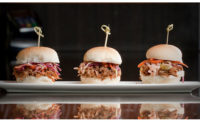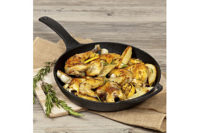It would be hard to imagine any restaurant featuring burgers and champagne opening during the recession, as did Chicago’s popular Au Cheval. So is the time right for foodservice operators, particularly upscale casual restaurants, to adjust their menus to a post-recession reality?
Yes and no. High beef prices still push operators to find creative ways to keep prices down, such as whole animal consumption and mixing other ingredients in with ground beef. But yes, consumers are more open to creative dining formats and entrees at upscale casual restaurants, and at home with meal delivery services.
“As the recovery unfolds, so do our senses and the usual fare doesn’t satisfy our needs as it does during more difficult times — now is not the time for comfort food,” says Suzy Badaracco, president of Culinary Tides, Inc., in Portland, Ore.
The $437 billion restaurant industry, which includes both full-service and limited-service restaurants, is expected to reach $562 billion by 2019, according to Chicago-based Mintel’s “Dining Out: A 2015 Look Ahead” report.
The report notes more consumers are expected to eat out regularly this year. But some key demographic groups including younger diners, women and minorities may still focus on price when selecting restaurants, because of a bumpy economy.
Many full-service restaurants now try to appeal to time-conscious consumers by providing the faster service of fast-casuals, revamping menus to offer more fresh foods and renovating locations to appear more welcoming, Mintel reports.
By the numbers
As the number of chicken and beef entrées has increased slightly from the second quarter of 2014 to the second quarter of 2015, fish and shellfish entrées have decreased at restaurants, according to Technomic’s MenuMonitor database, largely because of higher prices.
“This decrease is a result of rising commodity prices for seafood, particularly for shrimp, along with restaurant’s overall efforts to streamline menus to cut down on costs,” says Anne Mills, consumer insights manager at Chicago-based Technomic, Inc. “There has been a greater decrease in the number of items at seafood concepts than at steak concepts compared to last year.”
Beef and seafood entrées are more popular than chicken and pork entrées at these chains, she says.
“Steak and seafood concepts make up about 40 percent of upscale casual-dining restaurants within the Top 750 chains,” Mills says. “Other proteins like chicken can help minimize the veto vote at these chains and do still fit well at other types of concepts.”
Poultry and pork are gaining momentum due to high beef prices, and their popularity will continue as along as beef prices remain high, she says.
“Chicken is in its hey day because of its versatility and availability,” says Mark DiDomenico, director of client solutions at Datassential, in Chicago. “I do see there could be a decline in beef based off its prices.”
Hybrids, mash-ups and stuffed foods fit well within the protein category, says Badaracco, and show up in the early stages of an economic recovery.
“They will eventually give way to more fusion and then molecular gastronomy,” she says. “Hybrids and mash-ups include the beefalo and iron age pigs. Here the protein is the leading lady.”
Stuffed foods on the menu today may include stuffed roasts, chicken, pupusas, kolache and ravioli.
As consumers become more experimental and adventurous with their meals, they seek exotic and fringe proteins, as well.
“For seafood, it is alligator, lobster, langoustines, squid and trash fish [lesser-known fish species] including sablefish, wahoo, sheepshead and triggerfish, for example,” Badaracco says.
Lamb, bison, crickets and carpaccio are some of the more interesting headliners when it comes to animal protein, she notes.
Preparation matters
“I think we’ll see more innovation in the way proteins are menued that will highlight chefs’ skill set, but also help offset rising prices,” says Mills. “This could include smaller dishes, meat blends or slow-cooked beef cuts, for example.”
As some traditional beef entrees such as Angus beef and petite filets decrease in popularity, restaurants are experimenting with more specialty executions for beef instead of traditional uses, DiDomenico says.
“We’re seeing braised beef or short ribs instead of steak, for example,” he says. “It’s hard to say if this is a trend or reaction to price.”
Also, non-meat proteins such as hen and quail eggs and tofu are up considerably, he says, due to unique dish executions, their healthy halo, sustainability and the meatless movement.
“It is still a small category, but rising faster than others,” he says. Badaracco agrees: “For the first time, grains and legumes are acting as competitors to animal proteins,” she says. New, ethnic cuisines are also popular, DiDomenico says.
“The rise of the Food Network and celebrity chefs have caused diners to look for the new, hot trend sooner today than they would have five years ago,” he says.
The preparation of protein — frying, grilling or smoking — is just as important as the protein itself, says Andrew Freeman, president of Andrew Freeman and Co., restaurant and hospitality consultants, based in San Francisco.
“Personally, I feel we’ll see more smoking, braising and a preparation that uses the least calories — a new way to possibly showcase the quality and flavor of the meat in a low-calorie way,” he says.
High-protein diets certainly remain popular. But a new “safe indulgence” theory takes its cues from Weight Watchers diets: eat healthy most of the week and enjoy a few indulgences.
“Consumers may have fried chicken one night a week, for example, so they only want the best quality chicken when they indulge,” Freeman says.
Waste not, want not
Millennials are definitely interested in where their meat is raised and in using the whole animal, Freeman says.
“Their passion for quality has driven chains like McDonald’s and Panera Bread to look at their overall quality — changing over to antibiotic-free chicken, sustainable beef, no GMOs, etc.”
The idea of meal customization is important to all diners, even at a more formal restaurant. But Millennials are more likely than other groups to want to customize their dishes by selecting their protein, vegetable and salad, Freeman says.
How about choosing which parts of a steer to eat off the menu? Complete animal utilization has been around for thousands of years, but is just now appearing on menus, Freeman says.
Black Trumpet Bistro, for example, is a New Hampshire restaurant dedicated to creating dishes from one steer, using every part of that animal until it is consumed before repeating the process again with a new steer.
East Coast restaurants Moxy, Stages, Thistle Pig and Blue Moon Evolution have experimented with using whole goats, sheep and rabbits, and occasionally whole or half pigs.
“As diners get more comfortable, there will eventually be a tipping point into more adventurous cuisine,” Freeman says. “The Mexican culture takes more risk with pork, as well as Thai and Chinese.”
Dinner as theater
If the current economic recovery continues, we could be moving from hybrid foods to fusion cuisine — more art and play at work, Badaracco says.
“Dinner theater will become more common as diners are already looking for reasons to dine out beyond the food offered,” she says. “Dinner theater could range from deconstructed elements that allow the customer to participate in the meal’s construction, to watching chefs in an open kitchen, to servers building elements at the table.”
In general, there will be more emphasis on the sourcing and sustainability aspect of proteins and more transparency about where proteins are sourced from, says Mills.
“Along these lines, we expect to see more trash fish on menus as operators feature underutilized ingredients to boost sustainability efforts,” Mills says.
New proteins such as bison, deer and antelope could also become more popular. “They’ve always been done in more upscale restaurants,” Freeman says.
Right now, sausage and pork are growing, while chicken and beef decline in entrée sales, according to Datassential.
“There will be a move away from the more traditional items to specialty dishes and ethnic cuisine,” says DiDomenico. NP
Dining out at home
Just because someone is staying in for dinner doesn’t mean they want a boring experience. And today they don’t have to with interesting frozen meals, prepared meals at most retail outlets and pre-packed home meal components.
The $672.6 billion at-home market remains strong, despite away-from-home sales growing to $629.7 billion in 2012, according to Mintel’s report “Dining Out: A 2015 Look Ahead.”
“Consumers are eating more ethnic, global and regional foods at home, but are more willing to be experimental when they dine out,” says Suzy Badaracco, president of Culinary Tides, Inc., in Portland, Ore. “Protein though is still more sought after no matter the location, but the patterns are the same — more interest in protein yes, but it is vegetable proteins and seafood that are most prized in and out of the home.”
Consumers are trying to watch their waists and wallets.
Millennials are cutting back on trips to restaurants to cook at home. “They say they like or love even to cook at home because the food is fresher, tasty, cheaper and more convenient to them,” says Bonnie Riggs, restaurant industry analyst at The NPD Group, based in Port Washington, N.Y.
Millennials certainly like to eat at home, at least. Meal delivery services like San Francisco’s Munchery send high-quality, protein-driven home meal replacements to consumers’ homes. Other home meal services allow consumers to pick up pre-packed meal ingredients or pack them themselves.
“Millennials are driven by experiences, and I want what I want when I want it,” says Andrew Freeman, president of Andrew Freeman & Co., restaurant and hospitality consultants based in San Francisco.
Some retailers, such as Whole Foods, Trader Joe’s and Mariano’s, are more adventurous in their prepared meal offerings. But many retailers’ frozen food aisles have also been revamped to offer new and ethnic cuisines in a trusty format.
“Consumers can experience slow-cooked Korean beef barbecue, for example, in a frozen format a lot easier than making it themselves at home,” says Mark DiDomenico, director of client solutions at Datassential, in Chicago.
Add the egg hold the cheese
Today, hamburgers fit in just as well at upscale casual restaurants as they do at fast food chains.
In fact, the trusted sandwich makes up 15 percent of all restaurant orders, as of year-end July 2015, which equates to 8.9 billion burgers, according to The NPD Group’s Checkout Tracking.
“The burger is an American classic, right up there with Mom and apple pie,” says Bonnie Riggs, restaurant industry analyst at The NPD Group, based in Port Washington, N.Y. “When it comes to their burger, today’s consumers are placing more value on the quality, the freshness and the taste of a burger than its price or the convenience/ease of purchase.”
Restaurants are focusing on burgers because of their broad appeal, she says.
“There is minimal risk because burgers consistently rank among the top foods ordered at restaurants,” says Riggs.
In fact, more consumers are ordering burgers at casual dining restaurants today, and they are priced not much higher than quick service restaurants’ burgers —$9.02 vs. $5.62, according to NPD. Once fries are added to the total bill at an average of $2.89, the final tab is much closer.
According to the NPD Group’s CREST service, burger orders were up 3 percent at casual dining restaurants in June 2015, compared to a year ago. This was the only category to increase servings in casual dining. Quick service restaurants had flat burger sales.
Consumers want to eat out but can still be cautious and controlled in their spending. Burgers are well suited to weather most economic bumps in the road, as they can be an affordable option on the menu and remain price stable by mixing quality ingredients with ground meat or turkey.
The fact that not all burgers are created equal is an additional appeal for consumers and restaurants. Diners can now order burgers with eggs, brisket and doughnuts on them, to name a few choices.
“Burgers today come in a wide variety of tastes and sizes,” Riggs says. “What can be done with a burger seems to have no limit; burgers lend themselves to a great deal of innovation.”












